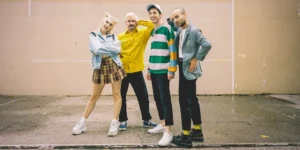Few brands in the world of streetwear have managed to maintain their relevance and desirability across multiple generations. A Bathing Ape (BAPE) is one of the rare exceptions. From its underground beginnings in Harajuku to becoming a globally recognized label, BAPE has continuously evolved while staying true to its streetwear DNA.
Founded by Nigo in 1993, BAPE was an early pioneer in the street fashion movement, blending Japanese design sensibilities with American hip-hop culture. Over the years, the brand has transitioned from an exclusive, hard-to-get label to a mainstream powerhouse without losing its credibility. Even with ownership changes and evolving consumer trends, BAPE has managed to stay relevant.
The Origins of A Bathing Ape: A Streetwear Revolution
In the early ’90s, Japan was experiencing a boom in youth subcultures, particularly in Harajuku, where a mix of Western influences and local creativity gave rise to a new fashion movement. This was where Nigo (real name Tomoaki Nagao), a young designer deeply influenced by hip-hop, punk, and vintage Americana, launched A Bathing Ape.
The brand’s name itself was a nod to “A Bathing Ape in Lukewarm Water,” a reference to the idea of young people living comfortably and indulging in luxury—a playful jab at consumerism. From the start, BAPE was designed to be an exclusive, insider brand, producing extremely limited quantities of its clothing.
This scarcity built hype. If you owned a piece of BAPE in the 1990s, you were part of an elite group. The limited supply and cult-like following helped cement BAPE’s reputation as one of the most sought-after streetwear brands in Japan.
The Blueprint for Hype: Scarcity & Exclusivity
One of the most critical strategies behind BAPE’s success has been its commitment to exclusivity. In its early years, Nigo intentionally kept production numbers low, making BAPE products difficult to acquire. This artificial scarcity created an insatiable demand, leading to long lines outside BAPE stores and resellers flipping items at premium prices.
Even as BAPE expanded, this drop culture strategy remained at the core of its brand philosophy. Instead of flooding the market with supply, BAPE controlled distribution carefully, ensuring that each new release felt like an event.
• Limited runs of products
• Surprise drops and collaborations
• Exclusive regional releases
By adopting these techniques, BAPE built a loyal community where ownership of the brand felt like membership in an exclusive club.
Collaboration Culture: Expanding BAPE’s Influence
Another major factor in BAPE’s longevity has been its ability to collaborate with cultural icons across different industries. From the early 2000s, BAPE tapped into the power of hip-hop, sports, and luxury fashion, solidifying its credibility across multiple markets.
Some of BAPE’s most legendary collaborations include:
Hip-Hop & Music Icons
• Pharrell Williams – One of the earliest adopters, Pharrell’s endorsement helped introduce BAPE to a global hip-hop audience.
• Kanye West – His Bapesta sneaker collaboration remains one of the most coveted in sneaker history.
• Lil Wayne, Soulja Boy, The Notorious B.I.G. – All rocked BAPE, further pushing it into mainstream rap culture.
High-End Fashion & Luxury Crossovers
• Louis Vuitton x BAPE (2009) – An unofficial crossover where Nigo’s influence brought BAPE’s aesthetic into the world of high fashion.
• COMME des GARÇONS x BAPE – A collaboration that blended two Japanese fashion giants.
Pop Culture & Entertainment
• Marvel x BAPE – Tapping into superhero fandoms.
• Star Wars x BAPE – A legendary pop culture collaboration.
• Nintendo x BAPE – Merging gaming culture with streetwear.
By aligning itself with cultural tastemakers, BAPE ensured it remained on the cutting edge of trends. These collabs kept the brand fresh, desirable, and relevant to new audiences.
The Evolution from Cult to Mainstream
A turning point for BAPE came in 2011, when Nigo sold the brand to Hong Kong-based I.T Group. Many feared this would lead to a dilution of its exclusivity. However, under new ownership, BAPE managed to expand globally without losing its streetwear credibility.
Key Expansion Moves Post-2011:
More Stores in the US and Asia – Expanding its footprint while maintaining the hype.
Increased Production – While still exclusive, BAPE increased supply to tap into a broader audience.
More Collaborations – Expanding into sneakers, gaming, and sports further boosted visibility.
Rather than alienating hardcore fans, BAPE struck a balance between mass appeal and streetwear authenticity.
The Bapesta: A Sneaker That Defined an Era
No discussion about BAPE is complete without mentioning the Bapesta, one of the most iconic sneakers in streetwear history. Launched in the early 2000s, the Bapesta’s design was heavily inspired by the Nike Air Force 1, but with a distinctive star logo replacing the Swoosh.
The Bapesta became a grail sneaker for many, especially after being worn by artists like Kanye West and Pharrell. The shoe symbolized an era of streetwear where Japanese fashion and American hip-hop culture collided in the most perfect way.
Even today, vintage Bapestas are highly sought after, proving the longevity of BAPE’s design ethos.
BAPE’s US Expansion: What’s Next?
Now, in 2024, BAPE is setting its sights on expanding its US presence. With flagship stores in cities like New York and Los Angeles, the brand is pushing further into the American market while still maintaining the exclusivity that made it famous.
Challenges in the US Market:
• Increased Competition – Brands like Supreme, Kith, and Off-White dominate the streetwear space.
• Balancing Hype & Accessibility – Too much availability could water down the brand’s mystique.
• Resale Market Issues – BAPE needs to manage its relationship with resellers who drive hype but also inflate prices.
Opportunities for Growth:
• BAPE’s legacy as an OG streetwear brand gives it an advantage over newer brands.
• Its pop culture appeal (gaming, anime, and music collabs) keeps younger audiences engaged.
• The nostalgia factor attracts longtime fans who grew up with BAPE.
With a mix of innovation, smart branding, and cultural relevance, BAPE has the potential to dominate in the US market, just as it has in Japan.
Why BAPE Has Stayed Cool for Decades
At the heart of BAPE’s sustained success is its ability to evolve without losing its identity. While many brands peak and fade, BAPE has managed to:
Keep its exclusivity intact
Flow with the right cultural figures
Blend high fashion and streetwear effortlessly
Adapt to new markets while staying authentic
Even as trends shift, BAPE continues to capture the essence of street culture, proving that some brands are built to last. Whether you’re a longtime fan or a new adopter, A Bathing Ape remains one of the most iconic streetwear labels in the world—and its influence is far from over.
No comments yet.







